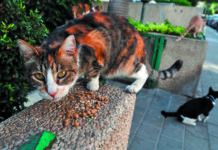Cat Ravenously Hungry? It’s Not Normal
If your cat has developed a voracious appetite in which she scarfs up her food and frequently begs for more, it’s not normal, and she should see a doctor. Possible reasons for an insatiable appetite can be behavioral or physical.
How Frail Is Your Cat?
One of the reasons the Feline Veterinary Medical Association says cats 11 through 15 should have a twice-yearly vet visit and cats older than 15 should go for a checkup three times a year is that older cats should be routinely assessed for frailty. While old age is not a cause of frailty in itself, advanced age is associated with the condition. It’s a serious one. Considered a syndrome, frailty signifies decreased functional reserve that leads to declines both physiologically and cognitively. It also means the body has less of an ability to mount a defense against adverse medical events.
7 Ways to Improve Your Relationship with Your Cat
You love your cat, want to do right by her, and make her feel good about you and about living in your home. Here are seven ways to do just that. They will greatly improve your relationship with your feline family member.
The Myth of the Hypoallergenic Cat
You see an ad for Siberian forest kittens that promises they are hypoallergenic. You then make a mental note to yourself about your next cat, since the one you have makes your eyes water and your throat scratchy. But that breed can bring out your allergy, too. What gives?
More Consistent Testing for Heartworm Disease Advised for Cats
Dogs are routinely tested for heartworm disease during their annual physicals. Not so, cats, even though they are at risk wherever heartworm infection occurs in their canine counterparts—it results from being bitten by an infected mosquito.
Cat keeps human(e) hours
Q: I know that cats are nocturnal, but mine keeps the same sleeping and waking hours I do, more or less. Is there something off about her feline biorhythm?
About That Pet Food Advice from the Store Clerk
We not infrequently hear from our clients that they chose their cat’s food based on the recommendation of someone who works at the pet shop. Not to diminish the good work of store staff in any way, but would you build a nutritious diet for yourself based on the advice of someone who works at the supermarket?
Turning a stray cat into a house cat
Q: I have been feeding a cat outside my home, and he has actually let me start petting him and shown interest when I leave the door open. I am thinking about adopting him. I know there’s a lot to consider, including whether he’d been be happy as a house cat. But my upfront concern is the cat I already have. Any suggestions?
“Cat Cavity” is a Misnomer
You may hear some people refer to cat cavities. But cats don’t get cavities. Their teeth don’t touch each other in a way that lets cavity-causing bacteria collect between them, and they don’t have little pits and fissures in their teeth, like people do, where cavities form. The pH of their saliva also stops cavity formation.
Download The Full January 2025 Issue PDF
- What Does It Mean When My Cat…
- Morsels :Why Cats Could Never Survive on Dog Food; Did You Try Coating the Pill in Butter?; Just How Much Cats Love Tight Spaces.
- Cats Just Want to Have Fun
- There’s Good News if Your Cat is Diagnosed with Diabetes
- Head Pressing: It’s Serious
- Updated Disaster Preparedness Guidelines
- E-Collar Alternatives
- Dear Doctor: My cat keeps giving me “gifts”; Choosing a veterinary practice behavior
What Does It Mean When My Cat…
Is your cat happy? Bored? Something else? Here are a few ways to tell.
Why Cats Could Never Survive on Dog Food
If your cat occasionally gets into your dog’s food, it’s no big deal. But cats have unique nutrition requirements that dog food simply cannot cover. In fact, it would be much easier for a dog to get by on cat food than vice-versa.















